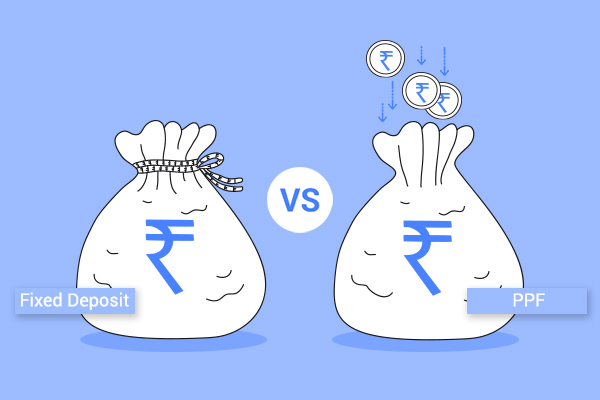Fixed Deposit Vs Public Provident Fund: Which is Good?

The full form of PPF is Public Provident Funds and the full form of FD is Fixed Deposits. These are both financial tools that help you grow your money safely. Both these investment options can help you accumulate savings for a rainy day or plan your retirement. However, as both have unique features and benefits, it can get confusing to decide between the two options. Here is everything you need to know about PPF and FD to help you choose the suitable option for yourself.
What is a Fixed Deposit?
A Fixed Deposit is a low-risk investment option under which the investor can invest a lump sum amount with a bank for a fixed tenure and a pre-decided interest return. FDs are guaranteed returns investment tools, and the returns are not affected by market highs and lows. FD interest rates in India vary between banks, and senior citizens usually get a slightly higher interest return than others. Investors can use an online FD calculator to calculate their returns on an FD.
Features and Benefits of a Fixed Deposit
- Fixed deposits have a flexible tenure, and the investor can invest in an FD for a period of their choice. It can be anywhere between 7 days to 20 years, depending on the financial goals and requirements.
- When an FD matures, the investor gets a pre-decided return on their investment, and the return does not depend on the prevailing market conditions. They would get the same returns even in times of a market slump.
- You can opt for a Cumulative FD under which you can earn interest on your reinvested interest and get higher returns.
- FDs can also be a regular income source if you opt for a non-cumulative FD and get periodic interest payouts.
- Senior citizens can get additional benefits on their Fixed Deposits through higher interest returns. They can use an FD calculator to calculate the FD returns.
- There are tax exemption FDs under which you can save on income tax payments.
What is a Public Provident Fund?
Public Provident Fund is a government-backed financial tool that also leads to tax savings for the investor. These funds are offered by the post office or banks and are completely safe since the government guarantees them.
Features and Benefits of a Public Provident Fund
- The tenure of a PPF is a minimum of 15 years, and you can increase it by multiple of five years. It is a long-term saving tool.
- An investor can deposit a minimum of Rs.500 in a PPF, which can go up to Rs.1.5 lakhs in a financial year.
- PPFs are tax-saving instruments, and an investor in PPF can get a tax exemption of up to Rs.1.5 lakhs annually.
- To maintain the PPF, the investor must invest at least once a year for at least 15 years.
- There are multiple modes of investment in a PPF, and you can invest through a cheque, cash, demand draft, or online fund transfer.
- Investors can nominate in the PPF when they open a PPF account or later on.
- PPFs come with minimum risk and guaranteed returns and keep your capital safe.
Difference Between Fixed Deposit and Public Provident Fund
Parameters |
Fixed Deposit |
Public Provident Fund |
Issued By |
Banks and Non-Banking Financial Companies |
Indian Government |
Minimum Amount you can Deposit |
Rs.5,000 |
Rs.500 |
Liquidity |
Moderate |
Low |
Tenure |
7 days to 20 years |
15 years that can be increased in blocks of 5 years |
Eligibility |
Indian residents, NRIs, Corporations, Trusts, Hindu United Families |
Residents of India |
Joint Account |
Allowed |
Not allowed |
Interest Returns |
Up to 7.5% with some banks |
Up to 7.1% |
Loans Against the Instrument |
Available |
Available only after 3 years |
Premature Withdrawals |
Allowed |
Allowed after 5 years |
Tax on Interest |
Some FDs are tax exempted |
Fully tax exempted |
Tax on Investment |
Available on tax exemption FDs |
Available on all PPFs |
The Final Word
A PPF is a better long-term investment than an FD because it helps you achieve long-term goals. In the current scenario, Fixed Deposits and Public Provident Funds are both good investment instruments. Depending on your investment needs and time horizon, you can choose between the two. If you are looking for a financial instrument with a relatively shorter and flexible tenure, you can opt for a Fixed Deposit. The FD rates in India differ for various banks, and you can opt for a bank with higher FD returns.

 Blog
Blog Blog
Blog



Comments
No comments yet.